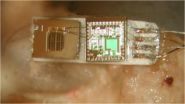(Press-News.org) It is important to be able to monitor genetically modified (GM) crops, not only in the field but also during the food processing chain. New research published in BioMed Central's open access journal BMC Biotechnology shows that products from genetically modified crops can be identified at low concentration, using bioluminescent real time reporter (BART) technology and loop mediated isothermal amplification (LAMP). The combination of these techniques was able to recognise 0.1% GM contamination of maize, far below the current EU limit of 0.9%.
In agriculture GM crops have been bred to improve crop yield or viability. For example some are resistant to herbicides or viruses. They are also used in the pharmaceutical industry to produce proteins such as collagen. However there is a constant debate about the safety of these crops and whether the man-made transgenes might enter the wild population by cross-fertilization.and produce herbicide resistant weeds.
Careful handling and sampling techniques are required to assess the GM content of a crop. The most common technique is polymerase chain reaction (PCR), however, this involves complex extraction procedures and rapid thermocycling, both of which require specific equipment. To overcome these problems researchers from Lumora Ltd. assessed whether they could use LAMP to amplify DNA at a constant temperature and use BART to identify GM-specific DNA in real time.
Dr Guy Kiddle from Lumora, who led the research, explained that LAMP-BART was able to detect as little as 0.1% GM contamination of maize, and, compared to PCR, was more tolerant of contaminating polysaccharides, meaning that the DNA clean-up process did not need to be as thorough. He commented, "This method requires only basic equipment for DNA extraction, and a constant temperature for DNA amplification and detection. Consequently LAMP-BART provides a 'field-ready' solution for monitoring GM crops and their interaction with wild plants or non-GM crops."
### Media Contact
Dr Hilary Glover
Scientific Press Officer, BioMed Central
Tel: +44 (0) 20 3192 2370
Mob: +44 (0) 778 698 1967
Email: hilary.glover@biomedcentral.com
Notes to Editors
1. GMO detection using a bioluminescent real time reporter (BART) of loop mediated isothermal amplification (LAMP) suitable for field use
Guy Kiddle, Patrick Hardinge, Neil Buttigieg, Olga Gandelman, Clint Pereira, Cathal J McElgunn, Manuela Rizzoli, Rebecca Jackson, Nigel Appleton, Cathy Moore, Laurence C. Tisi and James A.H. Murray
BMC Biotechnology (in press)
Please name the journal in any story you write. If you are writing for the web, please link to the article. All articles are available free of charge, according to BioMed Central's open access policy.
Article citation and URL available on request on the day of publication.
2. BMC Biotechnology is an open access, peer-reviewed journal that considers articles on the manipulation of biological macromolecules or organisms for use in experimental procedures, cellular and tissue engineering or in the pharmaceutical, agricultural biotechnology and allied industries.
3. BioMed Central (http://www.biomedcentral.com/) is an STM (Science, Technology and Medicine) publisher which has pioneered the open access publishing model. All peer-reviewed research articles published by BioMed Central are made immediately and freely accessible online, and are licensed to allow redistribution and reuse. BioMed Central is part of Springer Science+Business Media, a leading global publisher in the STM sector.
Bioluminescent technology for easy tracking of GMO
2012-04-30
ELSE PRESS RELEASES FROM THIS DATE:
Orangutans harbor ancient primate Alu
2012-04-30
Alu elements infiltrated the ancestral primate genome about 65 million years ago. Once gained an Alu element is rarely lost so comparison of Alu between species can be used to map primate evolution and diversity. New research published in BioMed Central's open access journal Mobile DNA has found a single Alu, which appears to be an ancestral great ape Alu, that has uniquely multiplied within the orangutan genome.
Analysis of DNA sequences has found over a million Alu elements within each primate genome, many of which are species specific: 5,000 are unique to humans, ...
Breastfeeding is associated with a healthy infant gut
2012-04-30
Early colonization of the gut by microbes in infants is critical for development of their intestinal tract and in immune development. A new study, published in BioMed Central's open access journal Genome Biology, shows that differences in bacterial colonization of formula-fed and breast-fed babies leads to changes in the infant's expression of genes involved in the immune system, and in defense against pathogens.
The health of individuals can be influenced by the diversity of microbes colonizing the gut, and microbial colonization can be especially important in regulating ...
A middle-ear microphone
2012-04-30
SALT LAKE CITY, April 30, 2012 – Cochlear implants have restored basic hearing to some 220,000 deaf people, yet a microphone and related electronics must be worn outside the head, raising reliability issues, preventing patients from swimming and creating social stigma.
Now, a University of Utah engineer and colleagues in Ohio have developed a tiny prototype microphone that can be implanted in the middle ear to avoid such problems.
The proof-of-concept device has been successfully tested in the ear canals of four cadavers, the researchers report in a study just published ...
Yellowstone 'super-eruption' less super, more frequent than thought
2012-04-30
PULLMAN, Wash.— The Yellowstone "super-volcano" is a little less super—but more active—than previously thought.
Researchers at Washington State University and the Scottish Universities Environmental Research Centre say the biggest Yellowstone eruption, which created the 2 million year old Huckleberry Ridge deposit, was actually two different eruptions at least 6,000 years apart.
Their results paint a new picture of a more active volcano than previously thought and can help recalibrate the likelihood of another big eruption in the future. Before the researchers split ...
Gladstone scientists identify brain circuitry associated with addictive, depressive behaviors
2012-04-30
SAN FRANCISCO, CA—April 29, 2012—Scientists at the Gladstone Institutes have determined how specific circuitry in the brain controls not only body movement but also motivation and learning, providing new insight into neurodegenerative disorders such as Parkinson's disease—and psychiatric disorders such as addiction and depression.
Previously, researchers in the laboratory of Gladstone Investigator Anatol Kreitzer, PhD, discovered how an imbalance in the activity of a specific category of brain cells is linked to Parkinson's. Now, in a paper published online today in Nature ...
Tablet-based case conferences improve resident learning
2012-04-30
Tablet based conference mirroring is giving residents an up close and personal look at images and making radiology case conferences a more interactive learning experience, a new study shows.
Residents at Northwestern University in Chicago are using tablets and a free screen sharing software during case conferences to see and manipulate the images that are being presented.
"The idea stems from the fact that I was used to having presentation slides directly in front of me during medical school lectures. I thought this would benefit radiology residents, especially in ...
MR enterography is as good or better than standard imaging exams for pediatric Crohn's patients
2012-04-30
MR enterography is superior to CT enterography in diagnosing fibrosis in pediatric patients with Crohn disease and equally as good as CT enterography in detecting active inflammation, and a new study shows.
The study, conducted at Massachusetts General Hospital in Boston, found that MR enterography was 77.6% accurate in depicting fibrosis compared to 56.9% for CT enterography. MR enterography had an 82.1% accuracy rate versus 77.6% accuracy rate for CT enterography for detecting active inflammation, said Keith Quencer, MD, one of the authors of the study. The study ...
Radiologists rank themselves as less than competent on health policy issues
2012-04-30
Radiologists classify themselves as less competent than other physicians regarding knowledge of patient imaging costs and patient safety, a new study shows.
The study conducted at Thomas Jefferson University in Philadelphia and Northwestern University in Chicago compared 711 radiologists to 2,685 non-radiology physicians. "On a scale of one to five, with five being highly competent, understanding of patient safety was rated as 3.1 by radiologists and 3.33 by non-radiologists," said Rajni Natesan, MD, an author of the study from Northwestern University. Patient imaging ...
Study examines benefit of follow-up CT when abdominal ultrasound inconclusive
2012-04-30
About one-third of CT examinations performed following an inconclusive abdominal ultrasound examination have positive findings, according to a study of 449 patients at Massachusetts General Hospital in Boston.
Opinions vary as to the need and relevance for further diagnostic imaging workup after an inconclusive abdominal ultrasound examination, said Supriya Gupta, MD, one of the authors of the study. "Our study found that 32.9% of follow-up CT examinations had positive findings, while 42.7% had findings that were not significant and 11.7% were equivocal. The remaining ...
Researchers question pulling plug on pacifiers
2012-04-30
BOSTON – Binkies, corks, soothers. Whatever you call pacifiers, conventional wisdom holds that giving them to newborns can interfere with breastfeeding.
New research, however, challenges that assertion. In fact, limiting the use of pacifiers in newborn nurseries may actually increase infants' consumption of formula during the birth hospitalization, according to a study to be presented Monday, April 30, at the Pediatric Academic Societies (PAS) annual meeting in Boston.
Studies have shown that breastfed infants have fewer illnesses such as ear infections and diarrhea ...

